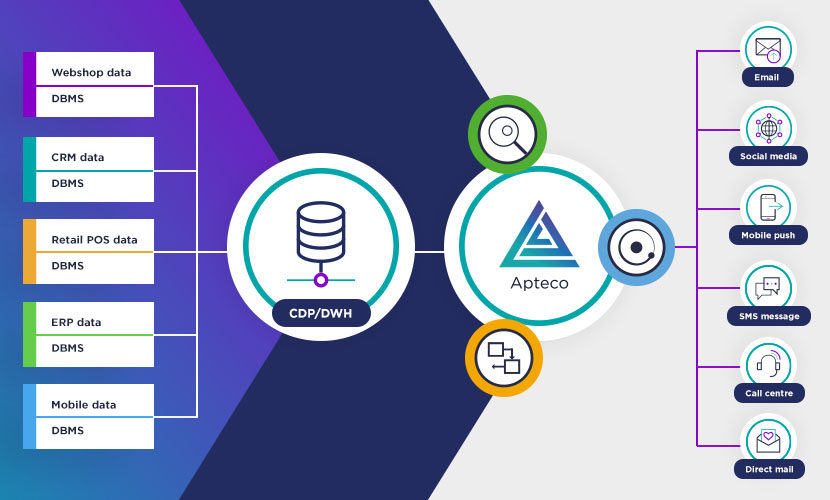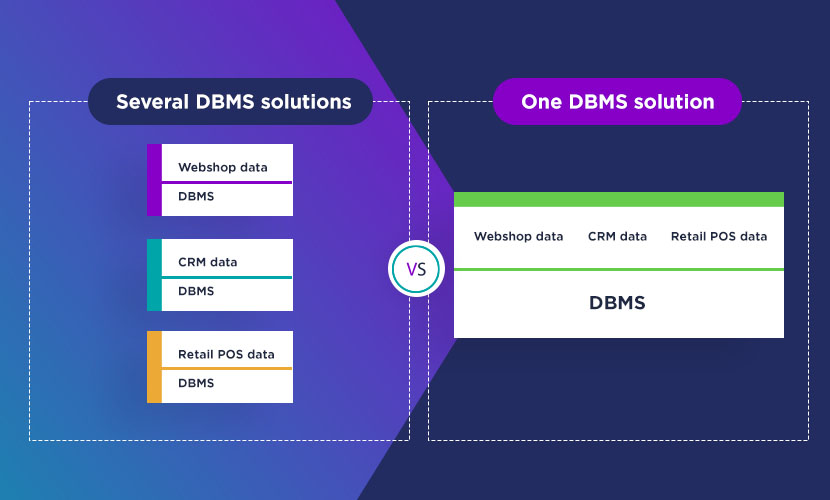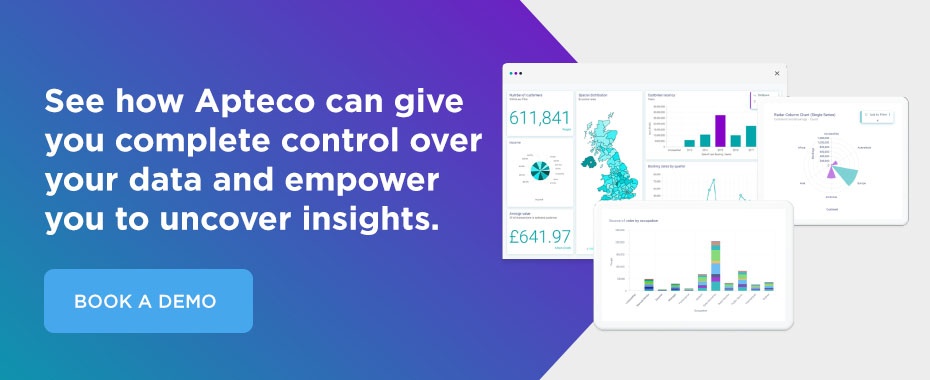What is database management software?
18 Aug 2021 | by Darron Gregory
Darron Gregory, an experienced data expert from our partner TAP London, looks at how to define database management software (DBMS), the advantages for marketers, and what to look for when choosing a solution.
In its most straightforward form, database management software (DBMS) allows users to take control of the creation and day-to-day running of different types of databases. Whereas some time ago a clear distinction could be made between relational and NoSQL databases, nowadays the boundaries are becoming increasingly blurred.
There are mainly three characteristics that define databases:
- Consistency
- Availability
- Partition tolerance
According to the so-called CAP theorem, it’s impossible for a database to simultaneously provide more than two of these characteristics.
Mostly interchangeable with Database Management Systems, DBMS has become an integral part of nearly all organisations’ activities.
Database management tools have been around since the 60s or 70s in one form or another, so they have a deep and long heritage.
However, it’s never been more confusing as to what DBMS is and why we should care about it. This is largely because the change of pace in what it can do and how we can use it has probably never been greater than it is today – interestingly, neither has the investment in DBMS.
This blog seeks to provide some clarity on what DBMS is, and why it is so important to all businesses that care about:
- Quality of information
- Usability and accessibility of data
- Security of vital business data assets
- Control of business processes
Advantages of database management software

Most of us rely on data to help us make decisions. How well we organise and present our data is often what makes the difference between a good data-led decision and a bad one.
Ultimately, few companies actually want a DBMS – what they want is what it can do for them. They want the capabilities that well-organised data can bring:
- Better customer engagement and valuable customer experiences
- Improved campaign response rates
- Greater understanding of behaviour
- Actionable insights
- Accurate and timely processing of transactions
So, a well-constructed, well managed DBMS capability should provide the data that’s needed, when it’s needed, in the correct format, to support these business goals. The DBMS is not itself a goal.
From a FastStats perspective:
I’m proud to say that I’ve been a certified FastStats trainer for many years. When introducing FastStats to a new user I always make it clear, in line with the FastStats mantra, ‘FastStats is a reflection of your data’.
Therefore, if actionable insights is your goal and you want an excellent FastStats system you need to have good quality, well-constructed, well-managed data. You need DBMS.
From a TAP perspective:
We want our clients to create valuable customer experiences. These can only be provided if their data lives up to these same high standards. That’s why we are passionate about helping our clients make the right decision when it comes to the best DBMS for them, and then helping them get the most from their investment.
Common features in database management software
Irrespective of the type of DBMS you have (or want), it should provide some basic functions to be classed as DBMS.
Capabilities we expect from DBMS include:
- Access to the physical or virtual data storage
DBMS should provide the ability to manage the storage being used by the database. - Update and manipulation
Data is rarely static so DBMS should allow for the:- Ingestion of new data
- Update of existing data
- Removal of data
- Accuracy
Now more than ever, databases need to be accurate, consistent, and up to date. DBMS makes this as easy as possible. It should also have archive and deletion capabilities for out-of-date data and when a customer wants their information removed. - Backup and recovery
There should be the ability to create regular backups of the database contents and recover to earlier versions if there is a problem. - Presentation of data
There should be the provision (possibly through integration with other tools) to provide access to the contents of the database, in a structured and controlled way. This could also include the ability to make data available through APIs. Without this capability, the DBMS would be irrelevant anyway. - Security
DBMS should provide compliant measures to secure access to the data it contains. These measures should include access control, encryption of sensitive data, and auditing of events.
How is database management software different from traditional systems?
The above capabilities are perhaps a traditional view of the world of DBMS. When we think more about a current view compared to the traditional one, we also need to consider:
Where does DBMS function?
Traditionally, DBMS was an on-premise or hosted solution within an architecture controlled and administered by the company who owned the data, or its appointed agency. It’s equally common now for DBMS to exist wholly within a cloud environment and for it to interface via browser and/or API. This type of DBMS can also provide additional use cases that more traditional ones may struggle with, such as:
- Advanced data science techniques
By harnessing the power offered by cloud computing, deep learning can be undertaken on massive data sets to uncover trends in data and opportunities to market that would have previously been unattainable to all but a few very large corporations. - Event processing
DBMS would previously have been thought of as something that only provided access to data in a ‘rested’ or offline state. Now, it’s common for DBMS to play a role in processing triggered, streamed or event data, to make informed decisions in ‘real time’.
Other capabilities you need to manage your data:
- Data hygiene
All data ages and its accuracy can change from excellent at the point of creation to no longer fit for purpose. Couple that with the fact that even new data can have flaws, and it’s clear that we need the capability to cleanse our data constantly or periodically, and sort out the ‘good’ from the ‘could be improved’ to the ‘bad’.
DBMS does not necessarily come with all of the tools to make sure that data is of the highest quality when it’s entered, nor how good it is over time. Therefore one of the considerations if you are choosing a new solution should be: “how will data hygiene be maintained at the highest quality?” - Data governance
The introduction of GDPR has made all organisations reflect on the policies around their data and systems and how robust and fit for purpose they are. Couple this with the legal requirements that GDPR brings and the opportunities for large fines for data breaches, and the way we manage/govern our data has never been more important. Therefore, a good DBMS must be able to respect an organisation’s data governance policy and provide tools to simplify, control, and audit the process. - Data integration
The traditional view of DBMS has been one of a ‘presentation layer’ to provide access to data, often via a UI or through controlled data transfers (possibly via scheduled extracts). Today we expect data to be democratised, securely controlled, but available where it’s needed, when it’s needed. This means that the way in which data can be accessed within DBMS has never been more important.
Types of database management software
DBMS has evolved as general-purpose software. It’s neither sector nor application specific. Large applications have historically provided specialisations through predefined data models that relate to specific sectors, but now DBMS can be very targeted at a particular facet of operation. While many organisations will have a ‘master’ data repository, which could be classified as a DBMS, there will also be data lakes, data warehouses etc. that fulfil this requirement.
Therefore, it is becoming more common for a DBMS to have a specific role, such as:
- Data Management Platforms (DMP)
The primary role of a DMP is to access data and provide it to other systems, usually in an anonymised format. DMPs also organise the data to create audiences for personalised targeting, providing a tailored marketing journey. - Customer Data Platforms (CDP)
CDPs provide a wide range of capabilities, which include:- Interaction with delivery platforms
- Always-on customer profiles
- Marketer focused
- Unified persistent customer profile across systems and touchpoints
- Fully connected
- Reporting
A common use of DBMS is to provide structured information in a predictable and timely manner to a variety of different reporting platforms. - Campaigning/Communications
It’s also common to have DBMS capabilities built into campaign management systems used for communicating with customers and prospects. Some of these can be very sophisticated. - Analytics
Often a different approach to DBMS is to provide end-user self-service, real-time (possibly in the form of data streaming) and comprehensive integration across different data sources and destinations. - Operations
Making DBMS central to some operational requirements, such as single sign-on (SSO)/determining user access rights, CRM, finance, etc. - Distribution
A system that coordinates others, probably in different locations (on-premises, cloud etc.), often used to provide a central control of distributed systems, for redundancy and the enforcement of corporate standards and governance. - End user
By definition, something that is only used by one person. This could be something like Excel or single/private versions of enterprise software.
Another consideration here is whether your DBMS is a single platform or a collection of different ones.
There are two schools of thought here. Some organisations want to reduce their technology stack and consolidate into a single platform, while others prefer to go with ‘best of breed’, which also provides the opportunity to add (and subtract) individual components as required.

Most organisations will have their own view on which option is preferable here, based on a number of factors, and this view will probably change over time.
In my experience, even organisations that have decided to opt for a single vendor still need to supplement their DBMS with additional tools, specific to them or their sector.
An exciting, if somewhat daunting, market
In summary, the DBMS market has never been more exciting than it is today. The variety and choice of software is staggering; you only have to look at chiefmartec.com to appreciate this, and both Gartner and Forrester (amongst many others) are publishing emerging variants of DBMS applications to help guide us through the maze, such as:
- Forrester Wave™ Data Management for Analytics
- Magic Quadrant for Cloud Database Management Systems
So, if you are looking to improve your DBMS or are investigating implementing a new one, it can feel like a daunting task, but be reassured that help is at hand and hopefully this blog will provide some of that help to get you started.


